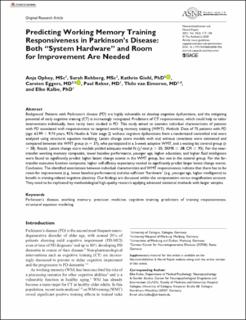| dc.contributor.author | Ophey, A. | |
| dc.contributor.author | Rehberg, S. | |
| dc.contributor.author | Giehl, K. | |
| dc.contributor.author | Eggers, C. | |
| dc.contributor.author | Reker, P. | |
| dc.contributor.author | van Eimeren, T. | |
| dc.contributor.author | Kalbe, E. | |
| dc.date.accessioned | 2021-10-05T11:52:59Z | |
| dc.date.available | 2021-10-05T11:52:59Z | |
| dc.date.issued | 2021 | |
| dc.identifier.citation | Ophey A, Rehberg S, Giehl K, et al. Predicting Working Memory Training Responsiveness in Parkinson’s Disease: Both “System Hardware” and Room for Improvement Are Needed. Neurorehabilitation and Neural Repair. 2021;35(2):117-130. | en_US |
| dc.identifier.uri | https://hdl.handle.net/11250/2787717 | |
| dc.description.abstract | Background. Patients with Parkinson’s disease (PD) are highly vulnerable to develop cognitive dysfunctions, and the mitigating potential of early cognitive training (CT) is increasingly recognized. Predictors of CT responsiveness, which could help to tailor interventions individually, have rarely been studied in PD. This study aimed to examine individual characteristics of patients with PD associated with responsiveness to targeted working memory training (WMT). Methods. Data of 75 patients with PD (age: 63.99 ± 9.74 years, 93% Hoehn & Yahr stage 2) without cognitive dysfunctions from a randomized controlled trial were analyzed using structural equation modeling. Latent change score models with and without covariates were estimated and compared between the WMT group (n = 37), who participated in a 5-week adaptive WMT, and a waiting list control group (n = 38). Results. Latent change score models yielded adequate model fit (χ2-test p > .05, SRMR ≤ .08, CFI ≥ .95). For the near-transfer working memory composite, lower baseline performance, younger age, higher education, and higher fluid intelligence were found to significantly predict higher latent change scores in the WMT group, but not in the control group. For the far-transfer executive function composite, higher self-efficacy expectancy tended to significantly predict larger latent change scores. Conclusions. The identified associations between individual characteristics and WMT responsiveness indicate that there has to be room for improvement (e.g., lower baseline performance) and also sufficient “hardware” (e.g., younger age, higher intelligence) to benefit in training-related cognitive plasticity. Our findings are discussed within the compensation versus magnification account. They need to be replicated by methodological high-quality research applying advanced statistical methods with larger samples. | en_US |
| dc.publisher | Neurorehabilitation and Neural Repair | en_US |
| dc.subject | Parkinson’s disease | en_US |
| dc.subject | working memory | en_US |
| dc.subject | precision medicine | en_US |
| dc.subject | cognitive training | en_US |
| dc.subject | predictors of training responsiveness | en_US |
| dc.subject | structural equation modeling | en_US |
| dc.title | Predicting Working Memory Training Responsiveness in Parkinson’s Disease: Both “System Hardware” and Room for Improvement Are Needed | en_US |
| dc.type | Journal article | en_US |
| dc.source.pagenumber | 117-130 | en_US |
| dc.source.volume | 35 | en_US |
| dc.source.journal | Neurorehabilitation and Neural Repair | en_US |
| dc.source.issue | 2 | en_US |
| dc.identifier.doi | https://doi.org/10.1177%2F1545968320981956 | |
| dc.description.localcode | måsjekkes | |
